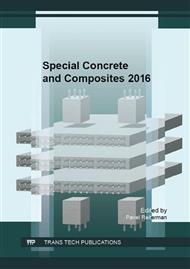[1]
Vogel, F., Holčapek, O., Konvalinka, P., Study of the Strength Development of the Cement Matrix for Textile Reinforced Concrete, Advanced Materials Research Vol. 1054 (2014) pp.99-103.
DOI: 10.4028/www.scientific.net/amr.1054.99
Google Scholar
[2]
Barhum, R., Mechtcherine, V., Effect of short, dispersed glass and carbon fibres on the behavior of textile-reinforced concrete under tensile loading, Engineering Fracture Mechanics 92 (2012) 56-71.
DOI: 10.1016/j.engfracmech.2012.06.001
Google Scholar
[3]
Graybeal, B.A., Baby, F., Development of Direct Tension Test Method for Ultra-High-Performance Fiber-Reinforced Concrete, ACI Materials Journal/March-April 2013, pp.177-186.
DOI: 10.14359/51685532
Google Scholar
[4]
Ohno, M., Li, V.C., A feasibility study of strain hardening fiber reinforced fly ash-based geopolymer composites, Construction and Building Materials 57, 2014, pp.163-168.
DOI: 10.1016/j.conbuildmat.2014.02.005
Google Scholar
[5]
Karihaloo, B.L., Abdalla, H.M., Xiao Q.Z., Size effect in concrete beams, Engineering Fracture Mechanics 70 (2003), pp.979-993, Elsevier Science Ltd.
DOI: 10.1016/s0013-7944(02)00161-3
Google Scholar
[6]
Bažant, Z.P., Size effect, International Journal of Solids and Structures 37 (2000) pp.69-80, Elsevier Science Ltd.
Google Scholar
[7]
Butler M., Mechtcherine V., Hempel S., Experimental investigations on the durability of fibre-matrix interfaces in textile-reinforced concrete, Cement & Concrete Composites 31 (2009), pp.221-231.
DOI: 10.1016/j.cemconcomp.2009.02.005
Google Scholar
[8]
Orlowsky, J., Raupach, M., Modelling the loss in strength of AR-glass fibres in textile-reinforced concrete, Materials and Structures (2006) 39, pp.635-643.
DOI: 10.1617/s11527-006-9100-5
Google Scholar
[9]
Vogel, F., Holčapek, O., Jogl, M., Kolář, K., Konvalinka, P., Development of Mechanical Properties of Steel Fibers Reinforced High Strength Concrete, Advanced Materials Research 1077 (2014), pp.113-117.
DOI: 10.4028/www.scientific.net/amr.1077.113
Google Scholar
[10]
Hartig, J., Jesse, F., Schicktanz, K., Häußler-Combe, U., Influence of experimental setups on the apparent uniaxial tensile load-bearing capacity of Textile Reinforced Concrete specimens, Materials and Structures (2012) 45: 433-446.
DOI: 10.1617/s11527-011-9775-0
Google Scholar
[11]
Tosun-Felekoglu, K., Felekoglu, B., Ranade, R., Lee, B.Y., Li, V.C., The role of flaw size and fiber distribution on tensile ductility of PVA-ECC, Composites: Part B 56 (2014) pp.536-545, Elsevier Ltd.
DOI: 10.1016/j.compositesb.2013.08.089
Google Scholar


